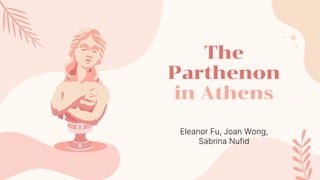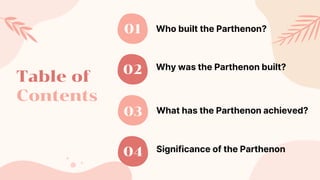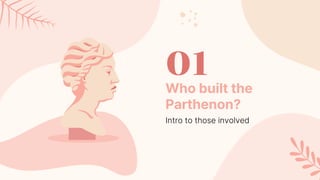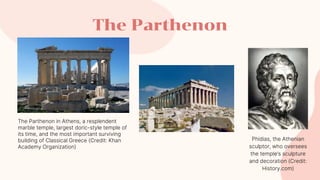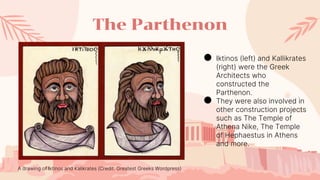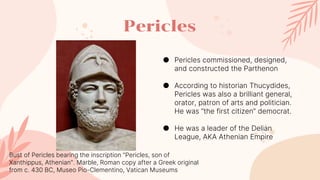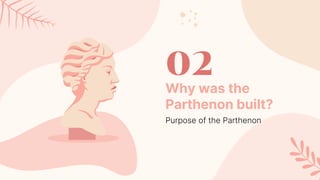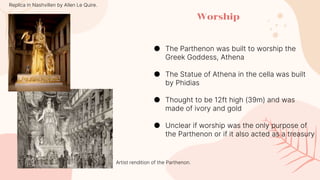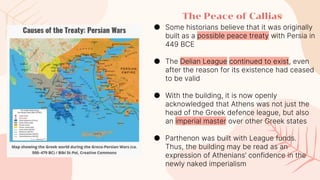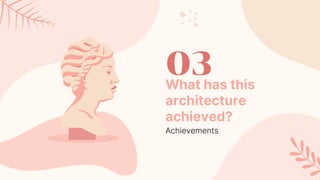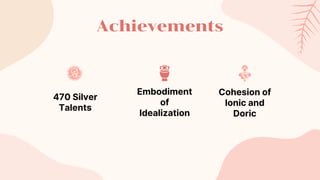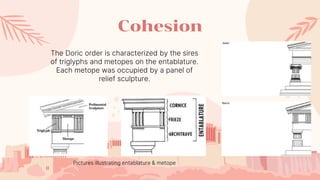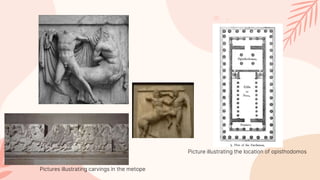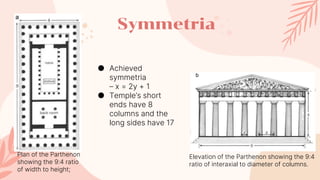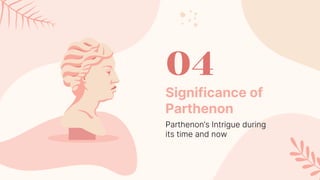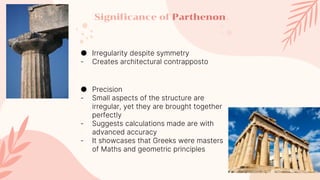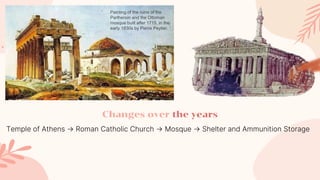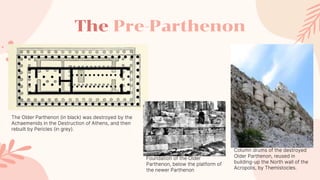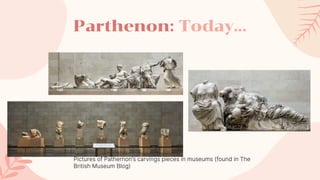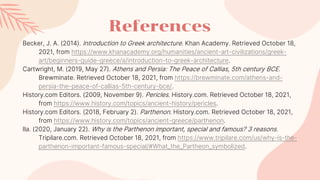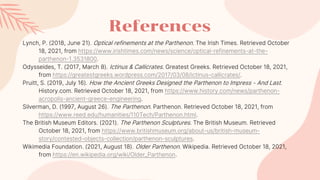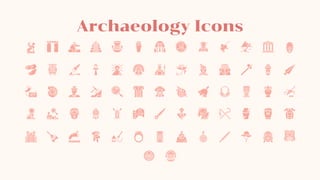The Parthenon in Athens.pptx
- 1. The Parthenon in Athens Eleanor Fu, Joan Wong, Sabrina Nufid
- 2. Who built the Parthenon? Why was the Parthenon built? What has the Parthenon achieved? Table of Contents 01 02 03 Significance of the Parthenon 04
- 3. Who built the Parthenon? 01 Intro to those involved
- 4. The Parthenon The Parthenon in Athens, a resplendent marble temple, largest doric-style temple of its time, and the most important surviving building of Classical Greece (Credit: Khan Academy Organization) Phidias, the Athenian sculptor, who oversees the temple’s sculpture and decoration (Credit: History.com)
- 5. ● Iktinos (left) and Kallikrates (right) were the Greek Architects who constructed the Parthenon. ● They were also involved in other construction projects such as The Temple of Athena Nike, The Temple of Hephaestus in Athens and more. The Parthenon A drawing of Iktinos and Kalikrates (Credit: Greatest Greeks Wordpress)
- 6. ● Pericles commissioned, designed, and constructed the Parthenon ● According to historian Thucydides, Pericles was also a brilliant general, orator, patron of arts and politician. He was “the first citizen” democrat. ● He was a leader of the Delian League, AKA Athenian Empire Pericles Bust of Pericles bearing the inscription "Pericles, son of Xanthippus, Athenian". Marble, Roman copy after a Greek original from c. 430 BC, Museo Pio-Clementino, Vatican Museums
- 7. Why was the Parthenon built? 02 Purpose of the Parthenon
- 8. Worship ● The Parthenon was built to worship the Greek Goddess, Athena ● The Statue of Athena in the cella was built by Phidias ● Thought to be 12ft high (39m) and was made of ivory and gold ● Unclear if worship was the only purpose of the Parthenon or if it also acted as a treasury Replica in Nashvillen by Allen Le Quire. Artist rendition of the Parthenon.
- 9. The Peace of Callias ● Some historians believe that it was originally built as a possible peace treaty with Persia in 449 BCE ● The Delian League continued to exist, even after the reason for its existence had ceased to be valid ● With the building, it is now openly acknowledged that Athens was not just the head of the Greek defence league, but also an imperial master over other Greek states ● Parthenon was built with League funds. Thus, the building may be read as an expression of Athenians’ confidence in the newly naked imperialism
- 10. What has this architecture achieved? 03 Achievements
- 11. Achievements Embodiment of Idealization Cohesion of Ionic and Doric 470 Silver Talents
- 12. Cohesion The Doric order is characterized by the sires of triglyphs and metopes on the entablature. Each metope was occupied by a panel of relief sculpture. Pictures illustrating entablature & metope
- 13. Pictures illustrating carvings in the metope Picture illustrating the location of opisthodomos
- 14. Plan of the Parthenon showing the 9:4 ratio of width to height; Symmetria Elevation of the Parthenon showing the 9:4 ratio of interaxial to diameter of columns. ● Achieved symmetria – x = 2y + 1 ● Temple’s short ends have 8 columns and the long sides have 17
- 15. Significance of Parthenon 04 Parthenon’s Intrigue during its time and now
- 16. Significance of Parthenon ● Irregularity despite symmetry - Creates architectural contrapposto ● Precision - Small aspects of the structure are irregular, yet they are brought together perfectly - Suggests calculations made are with advanced accuracy - It showcases that Greeks were masters of Maths and geometric principles
- 17. Temple of Athens → Roman Catholic Church → Mosque → Shelter and Ammunition Storage Painting of the ruins of the Parthenon and the Ottoman mosque built after 1715, in the early 1830s by Pierre Peytier. Changes over the years
- 18. The Pre-Parthenon Foundation of the Older Parthenon, below the platform of the newer Parthenon Column drums of the destroyed Older Parthenon, reused in building-up the North wall of the Acropolis, by Themistocles. The Older Parthenon (in black) was destroyed by the Achaemenids in the Destruction of Athens, and then rebuilt by Pericles (in grey).
- 19. Parthenon: Today... Pictures of Pathernon’s carvings pieces in museums (found in The British Museum Blog)
- 20. Thank You!
- 21. References Becker, J. A. (2014). Introduction to Greek architecture. Khan Academy. Retrieved October 18, 2021, from https://www.khanacademy.org/humanities/ancient-art-civilizations/greek- art/beginners-guide-greece/a/introduction-to-greek-architecture. Cartwright, M. (2019, May 27). Athens and Persia: The Peace of Callias, 5th century BCE. Brewminate. Retrieved October 18, 2021, from https://brewminate.com/athens-and- persia-the-peace-of-callias-5th-century-bce/. History.com Editors. (2009, November 9). Pericles. History.com. Retrieved October 18, 2021, from https://www.history.com/topics/ancient-history/pericles. History.com Editors. (2018, February 2). Parthenon. History.com. Retrieved October 18, 2021, from https://www.history.com/topics/ancient-greece/parthenon. Ila. (2020, January 22). Why is the Parthenon important, special and famous? 3 reasons. Tripilare.com. Retrieved October 18, 2021, from https://www.tripilare.com/us/why-is-the- parthenon-important-famous-special/#What_the_Partheon_symbolized.
- 22. References Lynch, P. (2018, June 21). Optical refinements at the Parthenon. The Irish Times. Retrieved October 18, 2021, from https://www.irishtimes.com/news/science/optical-refinements-at-the- parthenon-1.3531800. Odysseides, T. (2017, March 8). Ictinus & Callicrates. Greatest Greeks. Retrieved October 18, 2021, from https://greatestgreeks.wordpress.com/2017/03/08/ictinus-callicrates/. Pruitt, S. (2019, July 16). How the Ancient Greeks Designed the Parthenon to Impress - And Last. History.com. Retrieved October 18, 2021, from https://www.history.com/news/parthenon- acropolis-ancient-greece-engineering. Silverman, D. (1997, August 26). The Parthenon. Parthenon. Retrieved October 18, 2021, from https://www.reed.edu/humanities/110Tech/Parthenon.html. The British Museum Editors. (2021). The Parthenon Sculptures. The British Museum. Retrieved October 18, 2021, from https://www.britishmuseum.org/about-us/british-museum- story/contested-objects-collection/parthenon-sculptures. Wikimedia Foundation. (2021, August 18). Older Parthenon. Wikipedia. Retrieved October 18, 2021, from https://en.wikipedia.org/wiki/Older_Parthenon.
- 23. Archaeology Icons
- 24. Alternative Resources
Editor's Notes
- #5: The Parthenon is former temple of Athena that is currently located on the Athenian Acropolis in Greece. Work began in the midst of the Peloponnesian War in 447 BCE and was completed in 432 BCE. It was built during the height of Athenian imperial power, also known as the Ancient Greek Empire, and was unencumbered by the War The parthenon represents the maturity of the Greek classical form and withstood earthquakes, fire, wars, explosion, and looting over the years. In 2015, A panel of engineers discovered that the modular columns used to build the Parthenon were deliberately designed to have excellent seismic performance properties, which explains its ability to withstand earthquakes Even during its prime, The Parthenon was a powerful symbol of Ancient Greece and Athenian culture as it was the center of religious life in the powerful Greek CIty-State of Athens and was known as the largest and most lavish temple in the Greek Mainland. Hence, it was a symbol of power, wealth and elevated culture of Athens As we can see on the right, Pheidias was an Athenian sculptor who oversaw the temple’s sculpture and decoration
- #6: The temple of Huh fee stus
- #7: However, Pericles was the big main guy. He commissioned, designed, and constructed the temple. According to historian Thoo see duh dese, Pericles was a brilliant general in the Delian League AKA Athenian Empire, a mutual defence league against the Persians. He was also an orator, as well as the patron of arts and politician Thoo see duh dese also claimed that he was “the first citizen” of democratic Athen, who funded vast cultural projects in Athens besides the towering Parthenon. For instance, the temple of Athena Nike and the Erechtheum They were all built with the highest standards of aesthetics, engineering, mathematics, and all these white marble structures were decorated with intricate status and friezes carved by the era’s greatest sculptors.
- #9: The main purpose was worship. The temple was built to worship Athena, the Greek Goddess of Wisdom and War The statue of Athena in the cella built by Phidias Guarded in the eastern section, the statue was thought to have been 12 ft high (39m) and was made of ivory and gold. However, It is unclear if the Parthenon served only Athena or if it also acted as a treasury of the Delian League
- #10: At the same time, some historians believe that it was originally built as a possible peace treaty with Persia in 449, two years before work began on the Parthenon. The significance of this theory would be that the Delian League continued to exist, even after the reason for its existence had ceased to be valid. With the building of the temple, it now openly acknowledged that Athens was not just the head of the Greek defence league but also an imperial master over other Greek states. Since the Parthenon was built with League funds, the building may be read as an expression of the confidence of the Athenians in this newly naked imperialism. However, I would like to note that this theory is still debated amongst historians
- #12: It was estimated that 13,400 stones were used, which cost about 470 silver talents (about 9.4mil SGD) Similarly to Doryphoros of Polykleitos, with his obsession over the ideal proportions of the body, as seen from his works, the Parthenon is the architectural embodiment of idealization.
- #13: Doric is not only a type of column, but an "order"; this means that temples of the Doric order not only have this type of column, but also have a certain structure at the upper levels. The different types of orders (column plus entablature) are illustrated by these diagrams The Doric order is characterized by the series of triglyphs and metopes on the entablature. Each metope was occupied by a panel of relief sculpture.
- #14: However, the Parthenon combines elements of the Doric and Ionic orders. Basically a Doric temple, it features a continuous sculpted frieze borrowed from the Ionic order, as well as four Ionic columns supporting the roof of the opisthodomos. The carvings on the frieze were hand carved. They were designed to tell multiple stories on each side. For instance, one of its sides had a depiction of Gods battling giants and other creatures, such as centaurs. Another side tells the story of Athena - her birth, her fight with Poseidon, and the Greeks worshipping her. Meanwhile, the south side portrays the Trojan War.
- #15: Cella – the proportion of length to width, the distance between the centres of two adjacent column drums (the interaxial) in proportion to the columns’ diameter, and so forth.
- #17: Precision– from the above, if small aspects are so irregular, yet they can be brought together into one perfect piece, precision is needed. Calculations need to made with great accuracy. A show of how the Greeks were masters of Mathematics and geometric principles, highlighting their intelligence. Irregularity despite Symmetry E.g. the peristyle columns lean inward slightly. Those at the corners have a diagonal inclination and are also about two inches thicker than the rest. Creates architectural contrapposto
- #18: It has changed over time, with conquerors taking liberties. It had many different forms. The Parthenon, for example, was converted into a Byzantine and later a Roman Catholic church and then, after the Ottoman conquest of Greece, into a mosque. Each time the building was remodeled for a different religion, it was modified structurally. centre of religious life in Athens and it went through so many religious changes the Ottoman Empire converted the place of worship into an ammunition depot and shelter in 1687, causing massive structural damage as the ammunition got bombarded with cannonballs and exploded. However, despite the changes it had, the destruction over the years, it still stood till this day as one of the iconic pieces of Greek architecture.
- #19: In the past, The Parthenon was actually built to replace an existing temple which was destroyed by the Persians in 480BC as the Persian Empire attacked Athens and destroyed the Acropolis, which is the hill that the Parthenon currently sits on Earlier structures were known as the Older Parthenon or Pre-Parthenon. Building the current Parthenon helped transformed the city’s alliances into an empire and graced its Acropolis with the famous Parthenon.
- #20: Today, Fragments of the carvings and sculptures are scattered all over the world, including Paris, The Vatican, Copenhagen, Munich, Vienna, and Wurzburg. About half of the original surviving sculptures now resides in the British Museum, the other half remains in Athens. The British Museum also lends objects globally, allowing a wide audience to explore the History of the Parthenon. As a result, the history and significance of the Parthenon can live on
